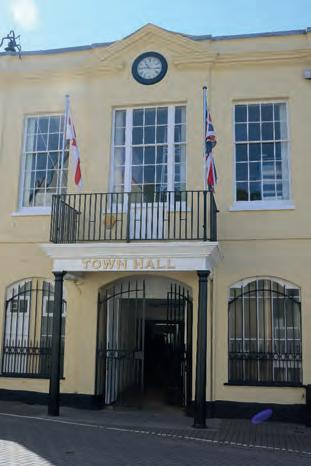






Somerset Confidential®
If you enjoy reading The Leveller® why not give our sister publication, Somerset Confidential® a go? Featuring many of the same writers as The Leveller®, Somerset Confidential® is an online news service. Delivered direct to your email inbox every week. It is delivered via the “Substack” platform. Somerset Confidential is not funded by advertising. All the work is carried out by independent journalists funded entirely by subscriptions. You can take a free subscription to get access to a lot of the material.
If you’d like to help us do more, a paid subscription costs just £30 (that’s equivalent to 58p a week) and gives you:
● 2 extra longform pieces each month
● Access to the full back catalogue of articles
● The opportunity to comment on articles
To sign up for Somerset Confidential just Google “Somerset Confidential substack” and follow the link then click on the tab “support Somerset Confidential®.
Letters to the editor
Dear Editor News of Charity Theatre Trips February 2024
With ten trips planned for 2024/25, and counting, there is plenty to tempt your readers to join us in the beautiful Bristol Hippodrome for our charity theatre trips.
Our coach starts at 5p.m. in Curry Rivel, then picks up in Langport & Somerton and either Keinton Mandeville & Shepton Mallet or Street & Wells. All profits are donated to British Red Cross The best way to keep up to date is at www.charitytheatretrips.com where there are full details and a booking form. Otherwise book by e-mail to charitytheatretrips@btinternet.com or phone Chris on 01458 273085.
Choose from:
Wicked: Thu 22 Feb: £66/£76; Edward Scissorhands: Wed 6 Mar; £52/£61; Jesus Christ Superstar: Tue 12 Mar: £45/£54; Everyone's Talking About Jamie:27 Mar: £40/£59; The Wizard of Oz: Wed 3 Apr: £47/£58; Sleeping Beauty Ballet: Fri 19Apr £38; Hamilton: Mon 10 June; £87/£97; Disney’s Aladdin: Thu 25 J\ul: £63/£73; Come From Away: Mon 26 Aug; £43/£68; Only Fools and Horses: Tue 4 Feb 2025: £61/£71
Yours sincerely
Chris Cox SomertonEditor
The writer is sure that the 'advancement' of Michael Eavis CBE to that of Sir Michael is long warranted, the 'courtesy' rightly extending to Lady Eavis. The licencing-regime for festivals was introduced at the Local Government Reform of 1974, subsuming urban/rural councils with the emergent Mendip District Council (of which the writer 'elected' an Independent Member for three subsequent quadrennials). It wasn't without controversy, Michael having promoted both CND/Green Peace and the removal of David Hathcoat Amory MP to Pilton incurring the 'ire' of many Conservative Councillor. Without any doubt the Eavis family having served the community over hundreds of years. The Eavis contribution to the international music scene ranks high on the international circuit. Perhaps HM could command the investiture be held on the 'hallowed' grounds of the Vale of Avalon amongst the annals of medieval Glastonbury with attendant Knights Pursuivant?
Yours sincerely
Graham E Livings, MineheadEditors’ Code
The Leveller® adheres to the standards set out in Editors’ Code. We operate a complaints procedure. If you wish to complain, please write to, or email the editor in the first instance (contact details as below).
Where to get your copy
The Leveller® is distributed on the 15th of the month via a network of local shops and pubs (see our website); we are very grateful for their support.
Our values
● Fair in our coverage
● Independent in our views
● Locally produced
● Promoting local enterprise
● Sensitive to the environment
● Careful with your data
Our Team
Editor: Andrew Lee: levellereditor@gmail.com
Staff Writers : Ancient Pistol: ancienpistolet@gmail.com
Writer at large: James Garrett
Sub Editor: Kate Roberts
Ad Manager: Ruth White levelleradvert@gmail.com
Ad Sales Executive: Juliet Barber levellermarketing@gmail.com
Art & Design: Rob Hutchinson
Advisory Board : Anthony Gibson, Paul Bell
Write to us at Leveller Publishing Group, Great Western House, Westover, Langport TA10 9RB
Advertise with us
We have a simple rate card offering ad sizes from an eighth of a page upwards. To request a rate card contact Ruth: levelleradvert@gmail.com or on 07973 758728
Juliet: levellermarketing@gmail.com 07544 737860
LevellerLive
For all our social media and online work we use the LevellerLive brand. You can find us on @LevellerLive on Twitter, Facebook, Instagram and YouTube.
For news between issues, go to our website: leveller.live
Copyright and


You should be able to get details of services and meeting dates via the contact details for your local council below:
Town Councils
Axbridge Town Council 07884 264033 https://axbridge-tc.gov.uk/
Bridgwater Town Council 01278 427692
Bruton Town Council 01749 813014 townclerk@brutontowncouncil.gov.uk
Burnham on Sea & Highbridge Town Council 01278 788088
townclerk@burnham-highbridge-tc.gov.uk
Castle Cary Town Council (01963) 359631 town.clerk@castle-cary.co.uk
Chard Town Council 01460 239567
Crewkerne Town Council 01460 74001
Dulverton Town Council 01398 324561 clerk@dulvertontowncouncil.co.uk
Frome Town Council 01373 465757 info@frometowncouncil.gov.uk
Glastonbury Town Council 01458 831769 office@glastonbury.gov.uk
Ilminster Town Council 01460 52149 town.council@ilminster.gov.uk
Your Council Contacts

Langport Town Council 01458 259700 office@langport.life
Martock Town Council 01935 822891 or 07506 286382 clerk@martock-pc.gov.uk
Minehead Town Council 01643 707213 info@mineheadtowncouncil.co.uk
North Petherton Town Council 01278 574074 townclerk@nptc.info

Shepton Mallet Town Council 01749 343984 info@sheptonmallet-tc.gov.uk
Somerton Town Council 01458 272236 town.clerk@somertontowncouncil.gov.uk
Street Parish Council 01458 440588 street.parish@street-pc.gov.uk
Taunton Town Council 01823 793637 Info@taunton-tc.gov.uk
Watchet Town Council 01984 633344 townclerk@watchettowncouncil.org
Wellington Town Council 01823 662855 info@wellingtontowncouncil.co.uk
Wells City Council 01749 673091 townclerk@wells.gov.uk
Wincanton Town Council 01963 31693 info@wincantontowncouncil.co.uk
Wiveliscombe Town Council 01984 631914 or TownClerk@wiveliscombe.com
Yeovil Town Council 01935 382424 ytc@yeovil.gov.uk
Somerset Council Office hours (8.30-5.00) service: 0300 123 2224
There’s no email contact for the council but there is a web page which allows you to report specific items to obtain information or make payment: https://www.somerset.gov.uk/contact-us/
The Somerset Day
15 January
Sunrise 8.09 am
Sunset 4.32 pm
15 February
Sunrise 7.25 am
Sunset 5.25 pm




Sky Diary by Paul Adamson
Moon Phases
First Qtr 18thJan / Full 25th Jan /
Last Qtr 2nd Feb / New Moon 9th Feb Planets
Venus dominates the early morning sky rising at 5.30am which is before sunrise and then Jupiter rules the evening sky setting at 1.45am, both these planets are very bright and hard to miss.
Constellation
Located to the left of Orion the Hunter is the Constellation of Gemini the twins with the Stars
Castor and Pollux forming the heads of the Brothers, look for a bright orange Star which is Pollux above which the faint
yellow star Castor can be found. Castor and Pollux are the twins from Greek mythology one being Mortal the other immortal.
Celestial Events
The Night of 3rd/4th January is the maximum of the Quadrantid meteor shower, the meteors radiate from the tip of the tail of Ursa Major the Great bear.

Somerset Stargazers monthly meetings are on the last Wednesday of the month except December for details please contact For details visit: somersetlevelsstargazers@hotmail.com


The announcement seemed a little bit like a Christmas present. The headline on the press release read: “Nearly 5,000 churches across the United Kingdom benefit from £42 million conservation fund”.
£42m? That is a lot of money. And it is not as if our churches do not need it.
There have been some generous grants from the £42m too. Leicester Cathedral has already received more than £600,000 as a contribution to the cost of restoring the historic building, including renewing the cathedral’s heating, lighting and electrics and creating a heritage learning centre for visitors from the local community and beyond.
Or the 12th-century Collegiate Church of St Mary in Warwick, which has been granted over £141,500 to repair the ancient tower, including work on the clocks and faces. Funding also supported the maintenance of electric and heating systems as well as new security and alarm systems.
But, let’s start by interrogating that headline. If you take £42m and divide it between 5,000 churches, that leaves an average grant of just £8,400 per church. That will not go far for the sorts of substantial repairs that many of our churches need. A new roof, for instance, or restoring mediaeval glass. And of course when you allow for the major grants of hundreds of thousands of pounds, the actual amount given to the rest is spread very much more thinly.
Heritage at Risk
churches in Somerset
St Mary Magdalene, Church Lane, Barwick and Stoford
Holy Trinity, Ash
Holy Trinity, Binegar
All Saints, Ashcott
St Andrew’s, Aller
Baptist Church, Beckington
John the Baptist, Brewham
St Nicholas, Bratton Seymour
Unitarian Chapel, Bridgwater
Baptist Church, Bridgwater
St Edward, Chiton Polden
John the Baptist, Chilcompton
St Vincent, Chilton Cantelo
St Mary, Donyatt
Christchurch, Frome
St Martin, Kingsbury Episcopi
St Giles, Leigh on Mendip
St Mary’s, Meare
St Mary, Nettlecombe
St Andrew’s, Mells
Holy Cross, Middlezoy
St Mary, North Petherton
St Michael and All Angels, Puriton
St Leonard, Rodney Stoke
St Thomas a Becket, South Cadbury
St Mary, Spaxton
St Mary, Charltons
St Mary, Stoke sub Hamdon
And then if you consider the population of churches as a whole? In England there are reckoned to be in excess of 15,000 grade-I-listed churches. In Somerset alone there are more than 470 grade I-, II- or II*-listed churches. So to discover that just 96 churches in Somerset received funding from this pot of money does not at first sight feel that encouraging.
St Peter, Hornblotten
St Peter, West Huntspill
St Mary, Westonzoyland
St Matthew, Wookey
St Mary, Kilmington
Not least because 33 Somerset churches, 33 are on the “Heritage at Risk” register. That is an alarming number of ancient buildings in our county to be considered “at risk”. Local stats
Perhaps it should come as no surprise that of those churches on the register only two, Bridgwater Baptist Church (£102,667) and St Peter and All Hallows, West Huntspill (£108,138) received a substantial grant. Christchurch Frome, also at risk, received £6,567 and two others received smaller grants.
But oddly, despite that, overall Somerset churches did not do badly from the deal. A total of £547,000 was given to Somerset Churches out of the £42m or around one and a half percent of the total.

Which is roughly proportional to the size of the county and the number of churches it contains relative to the country as a whole.
And although many of the churches on the Heritage at Risk register may have been overlooked other churches did benefit from the fund, although mostly from smaller awards. St Peter and St Paul, Bishops Hull, a church that has had major renovation work throughout the 19th and 20th century was granted £41,400. St Peter and St Paul in North Curry received an award of £30,400, All Saints Trull received £17,000 and St Mary’s East Brent were granted £17,100 and All Saints, Shepton Mallet £16,000.
Wells Cathedral received a grant of £17,441 which was no doubt welcome, but does not go far when measured against the estimated annual maintenance cost of around £1.5m for the cathedral.
However the vast majority of grants to our parish churches were small, a matter of anything from a few hundred pounds to the low thousands.
Leaving aside the two large grants to Bridgwater and West Huntspill, the remaining 96 churches in Somerset that received grants received an average of £3,505 each. While no parish church is going to complain about receiving a funding injection, for most it is a pinprick in the funding they need to keep the fabric of the church intact.
The grants, while welcome, really serve as a reminder that the funding structure for one of our most valuable heritage assets is far from secure.
While congregations and donations from the public struggle to raise the funds necessary to keep our parish churches in a good state of repair, government is not doing anything like enough to help bridge the funding gap.
The collection of parish churches and cathedrals across England is the forgotten jewel in our heritage crown. Nearly always the oldest building in the community, often adorned with astonishing paintings, stained glass and carved misericords, they are treasure troves of art and architecture. And represent a sense of continuity within the community as nothing else can. We need to value these assets.
Whether Britain is ready to go to the French model is perhaps a moot point. But it remains a fact that the French State owns and controls more than 32,000 churches, 6,000 chapels, and 87 cathedrals. Usually the parish church is owned by the commune and “rented out” to the clergy for religious observances. It does however put the burden of responsibility for repairs and maintenance firmly on the state and ensures there is more transparency over the raising and spending of funds. Whether that is the way forward or not, it does look as though the status quo is simply not good enough.



Left page
Left, Right and Over and Green!
The task we set our commentators this month was: As Somerset Council asks parish and town councils to take on more services from them, and to raise funding themselves to pay for it, are we effectively recreating lots of mini district councils by stealth?
These are the politicians tasked with giving you an answer: Left Page: Leigh Redman is a Somerset and Bridgwater town councillor and a Labour Party member.
Right Page: David Fothergill is a Conservative councillor for Monkton and North Curry. He is leader of the opposition on Somerset Council (SC).
Over The Page: Liz Leyshon is the Libdem Somerset Councillor for Street and is Deputy Leader of SC.
Green Page: Martin Dimery is the Green Party Leader on SC and candidate for the Frome & East Somerset constituency



The Left Page by Leigh Redman
The question talks about ‘mini districts’ & ‘stealth’, in Somerset. We have had mini districts before, they were called borough councils, but they were mostly disbanded when the two tier system was created!
Borough councils before 1970 existed within a complex system with varying levels of autonomy based on size, urban/rural location, and historical status. For most of Somerset you could say that they were like a small unitary council but then the national government stepped in.
District councils were created as part of the Local Government Act 1972, which introduced a uniform two-tier system of counties and districts from 1974 onwards. The act established elected county councils in England and Wales, as well as district councils. The two-tier system meant that each area would be covered by both a county council and multiple district councils. There has always been a third tier in all of the systems of government though. The lowest tier and closest to local people formed by town, parish and city councils. In Somerset in my experience they have always been willing to do more. They are the most local point of contact for communities. The financial crisis Somerset finds itself in, has been the catalyst for ramping up service devolution but in the current position it is a simple choice, cut or stop something completely or find another way.
You will have read many times that upper tier councils are limited in how much they can increase precepts, (the different strands that make up your council tax). Somerset is limited by government to a maximum 3% council tax rise, unless they want to hold a referendum. At the same time Somerset is having to find savings. Yet because of previous cuts, there is not much left to save. We are well ahead of many other councils when it comes to cuts. For example, we have not had proper youth services for years, children centres are gone, hedge and verge cutting is already at its lower limits, staff numbers are at minimum levels in most services. The Council Executive have decided, along with many other things, to try and find new service providers. Let me be clear, I am not happy with this position!
With the creation of the new unitary and the new council passing services down to parish town and city councils without the funding to go with them could be said to be a return to the 1970s system. The fact is that parish, town and city councils will have to increase their precepts to pay to provide these services. Which is wrong. This government has forced Somerset into this position and devolving services downwards is the last thing residents need. Somerset Council will need to go for a 3% rise in council tax to survive, the parishes and towns will have to raise tax to pay for the new services. All at a time when the cost of living crisis is already making life a misery for so many. The longer this government holds on the worse things will be. To answer the question: yes, we are creating mini districts in an obvious attempt to get local people to pay more, but it is the only thing the current administration can do to maintain and minimum level of service, because the government has tied their hands.


Right Page
by David FothergillOne of the key aspects of the Unitary business case was the financial balance required in devolving assets and services to Parish and Town Councils, to avoid any possible significant ‘cost shunting’. Time and again, at various public meetings, I spoke of the need to balance the financing of services with the income of assets, giving numerous examples including the devolution of local car park fees to fund additional local services.
Sadly like so much of the business case, including the role and funding of local community networks, the ‘no cost shunting’ principle was either lost or ignored when the new administration took over. Instead what we see now is a blatant attempt to fix the financial mess that has been made over the past eighteen months by layering substantial additional costs onto Towns and Parishes.
Unlike Somerset Council the smaller Town and Parish Councils have no ceiling on how much they can increase Council Tax by and already I am hearing of some Councils who intend to double their tax. This would be even more worrying for residents if Somerset Council also sought to set aside the legal requirement for a public referendum to break through the council tax limit. It would be ironic that the very principle, which is there to protect residents, was overridden by those who now run the County and many of the same, who argued so vociferously for a referendum previously!
Whilst I don’t believe this cost shunting will recreate District Councils it will create a two tier, postcode lottery of local services. Those Towns and Parishes who decide to accept (at their resident’s expense) the cost shunt will provide very different services from those who prioritise their resident’s ability to pay and the abilities of their voluntary Parish Councillors to manage demanding new responsibilities. This emerging new two-tier approach to services will inevitably disadvantage rural areas where Parish Councils are significantly smaller, have far fewer residents, struggle to get volunteers to be Councillors and do not have the Clerk capacity to increase their responsibilities.

Sadly therefore, what started out with a clear vision to invigorate all Towns and Parishes through a defined process of balanced devolution has turned into something best described as a dogs dinner, where a two-tier level of service will emerge, where Parish and Town Councillors will face demanding pressures and sadly, where those living in some parts of Somerset will finish up paying substantially more for what is currently universally provided. That sounds to me like something far worse than a simple cost shunt!



Over the page

 Over
Over
the Page
by Liz LeyshonI don’t see a recreation of district councils, of any size, but I do look back to pre-1974 when District Councils were created. Back then, the local councils had greater power and influence, especially the Mayors and Chairs, Clerks and Borough Surveyors. Read old records of Glastonbury’s Borough Council and you see much of their work was what we would now call public health intervention.
Services and assets including housing were managed locally, and I know plenty of people, mostly a little older, who think things ran much more smoothly then. The late John Brunsdon, Freeman of Glastonbury, published his memories of life in the town and I’ll always remember his words:
“Stan King was borough surveyor and George Harland was town clerk. It was said that between them they ran the town and the council was just an appendage. Essential works were well done and money largely well spent — largely because the direct labour force under Stan King would tackle every job that needed to be done as and when, with no time wasted.”
I’m not suggesting a return to those post-war ways but devolution of assets and services was an important part of both the One Somerset and Stronger Somerset business cases. The only difference now is the pace of change, not the intent.
My experience as a Mendip councillor taught me patience. As the Bishops Barn and Recreation Ground in Wells were returned to the City Council, I learnt how long it can take to complete a transfer of an historic asset.
As Street Parish Council enquired about the status of some open green spaces in the village, I learnt about restrictive covenants from the very early 20th century – written in beautiful copperplate in archaic terms but which are still binding.
As Glastonbury Town Council enquired about an asset in the town centre, I learnt about freeholds and leaseholds and how they combine in ‘marriage’.
I hope we will be able to move more decisively now but we don’t yet have a full team of property experts and lawyers; this work needs both time and expertise.
I realise that while we believe that local councils can deliver what local people want, that means many of them will raise the local precept to make priorities a reality. Some Councils have been working towards that for some time, understanding that as social care needs greater funding, local services and facilities will need increased local contribution.
It's not the local Councils that worry me. They are clearly ambitious and capable where that is needed, and cautious where their responsibilities are lesser.
My concerns are all with the Councils that have responsibility for social care, housing and homelessness. Where Council Tax is lower, need is generally higher.
If you get the chance to tell the Government that simple truth, please do.


Green
Page by Martin DimerySeason’s Greetings to all of you who trawl through all the political columns in The Leveller and stay the course long enough to read mine!
2023 was a memorable and frantic year. While I was busy coming third in the Somerton and Frome Parliamentary by-election (modesty forbids me to mention it was the best by-election result for a Green candidate in the party’s history), I was also getting my feet under the table as Chair of the Scrutiny Committee for Climate and Place on the new Somerset unitary council.
Just as the unitary regime was getting into its stride, we were hit with the bombshell that Somerset was a squillion pounds short in next year’s budget and might have to declare effective bankruptcy. This has brought forward some initiatives which attempt to off-load responsibilities on Parish and town councils.
Earlier in the year I attended a meeting with representatives of Frome Town Council and Somerset’s appointed street cleaning company. Frome TC were not happy with the quality of street cleaning in the town centre. Neither the Somerset representatives nor the contractor in question were at all keen to let Frome Town Council take over street cleaning, citing contractual obligations. No one was prepared to quantify what it would cost to outsource the contract to Frome. A few months later and Somerset Council are now desperate to offload the responsibility in the fire sale of council services. Things that were once the domain of the recently deceased districts could get devolved to the towns or even the new Local Community Networks, which are “regional” committees. In effect, this would be re-creating the kind of district structures we’ve just got rid of. A trifle ironic, I think you’d agree.
I have no problem with local communities running more of their own services, but here’s the catch: They will have to raise the money themselves by increasing their own bit of the Community Tax. I am hearing many complaints that in the rural areas, local parishes simply don’t have the desire or administrative experience- never mind the staff- to be able to fulfil any extra responsibilities. Perhaps the solution might be to revert to the Urban and Rural councils of 50 years ago, before they also fell foul of local government reorganisation.
Meanwhile, Somerset continues to operate several services like Planning Control in the underused former district council offices. Plus ca Change….
While this debate rumbles, the spectre of a General Election promises to make 2024 at least every bit as lively as 2023 for Somerset politics. I am fool enough to be standing again, but this time in the exciting new Frome and East Somerset constituency, half of which straddles the smaller and rather more stable council area of Bath and North East Somerset. Perhaps we in Frome should seek a transfer.

Happy New Year!






Update on work atYeovil District Hospital
If you’ve visited Yeovil District Hospital recently, you won’t have failed to notice that there’s a lot of building work happening… with even more on the way!
In early summer 2023 a brand new £5 million operating theatre was opened, a modular building that was craned into position.
The colleagues who work in the new theatre organise and perform a range of day surgery procedures where patients can now go home on the same day as their operation, including breast surgery, dermatology, plastic surgery and other general surgery. Alongside an improvement in the environment for colleagues and patients, the real stand-out benefit is how it’s freed up space in the main hospital theatres for the more complex procedures, helping to reduce waiting times for patients across Somerset who need an operation.
The hospital is continuing to run the ophthalmology diagnostic centre based in the Quedam Centre in the middle of town. Patients have said that they love the atmosphere there, especially the convenience of having all their tests and then popping to the shops or for a coffee!
Most of the patients seen in the centre either have a retinal or glaucoma problem, although the hospital is looking to expand into even more subspecialities in ophthalmology in the future, so it can make the best use of this great space. It also means that patients can benefit from the specialist assessment and treatment away from the busy hospital site.
One of the most recent developments that you’ll have most definitely seen
from the main Kingston Road, is the building of the new breast cancer unit. This has been a long time in the making, supported by the work of the amazing team of fundraisers and volunteers, raising an incredible £2.5 million for the new purpose-built unit, with a fantastic Paint the Park Pink event held by friends at Yeovil Town Football Club that pushed it over the finish line for

our fundraising.
The breast care team treats and cares for over 2,000 new patients and more than 3,000 follow-up patients every year at the hospital. It’ll be a place where they can get all their diagnostic tests and consultations under one roof, giving patients the best possible experience – comfortable and dignified. Hot on the heels of the breast cancer unit will be the construction of the new diagnostic centre, the second of its type in the county, following the Taunton Diagnostic Centre which opened in September 2021 and resulted in waiting lists for some tests falling dramatically. It will be a modern state-of-the-art stand-alone facility adjacent to the hospital and will provide more than 70,000 diagnostic tests and outpatient
A square circle by Laura Sorensen
by Dr Paul Fosterappointments a year – seven days a week.
Construction work is due to begin in spring 2024 with the centre expected to open in winter 2024. Looking further ahead into 2024, a new 20-bed planned care ward will open in spring, and then a fifth operating theatre is expected to be in place in 2025. Both these developments are expected to be for orthopaedic patients, but will flex where needed for other planned care. Funding for this £15 million development came from NHS England’s elective care recovery fund, which was announced by the Government in 2021 to help NHS trusts to tackle the backlog created by the COVID-19 pandemic. It came about following discussions about the length of the waiting list following the pandemic, as well as the predicted growth in the numbers of patients who’re likely to need care in the future.
The environment on the ward will be designed to create a tranquil space for patients to recover from their surgery rather than be cared for in a busy emergency or medical ward setting. All of these developments will help the hospital to tackle waiting lists and reduce pressures on the NHS for years to come.
All at the hospital are very excited about the continued development of services at Yeovil District Hospital across the county as part of Somerset NHS Foundation Trust and the NHS Long Term Plan.
Dr Foster is Site Medical Director at Yeovil District Hospital
Laura Sorensen went to a Somerset Wildlife Trust (SWT) Conference in Bridgewater and met Guy there. He was a SWT rep and in the course of conversation, Laura mentioned that she ran the local Glastonbury Repair Café. Guy had worked previously for a Housing Association (LiveWest) and done practical work for them. He said he knew of nearly new tools they were looking to donate to a worthy organisation who could use them.
So, Laura said “Yes please!”.
Glastonbury Repair Café often refers wooden repairs to the local Men’s Shed in Walton and Laura thought they could benefit from the tools as well..
The key players all met at the Street & Walton Men’s Shed on a Tuesday and Shona from the Housing Association handed over the tools. There were saws, drills, a hedge trimmer and other items, all still under guarantee. It was agreed not to sell them on, but use them for various community organisations.
Last month Glastonbury Repair Café donated £100 to SWT, so that nearly squares the circle of appreciating what the other does, whether it is mending household appliances, turning up new chair legs or caring for wildlife.
Leveller® subscriptions
The latest round of changes to the price of stamps is the second price hike this year by the Royal Mail (not the Post Office – they merely sell the stamps). The increase at the start of October was not so great for some classes of post or size/weight of letters.
For us the impact has been dramatic. The increase in the cost of sending out The Leveller to our subscribers rose from £1.85 to £2.40. And that was after a 20p increase earlier this year.
Sadly we have been forced to increase the charge for an annual subscription as a result.
We can only apologise to our subscribers, the new annual subscription will be £35, but it is quite genuinely beyond our control.
If you’d like to take a subscription with us, you can either go to the subscription tab on the Levell.live website or send a cheque payable to Even Handed Licensing Limited, to Great Western House, Westover, Langport, TA10 9RB.






Continued from p1
That, I was assured, was considered quite a modest haul of medication compared with some elderly people. However, the doctor decided to stop two of her blood pressure medicines –bisoprolol, a beta blocker which slows down the heart rate, and spironolactone, a diuretic or water tablet. This still left her with one other blood pressure medication, furosemide.
When I looked at drug interaction information on the NICE website, I understood the GP’s logic. Bisoprolol and spironolactone together increase the risk of low blood pressure; bisoprolol and furosemide can do the same. And it seems spironolactone is sometimes implicated in worsening kidney function. As NICE points out, older people are more sensitive to drugs. They may excrete them more slowly, so it’s more likely their kidneys will be affected, and they are also more likely to suffer from drug interactions or adverse effects from a particular medication.
A couple of days after coming off the two tablets, Mum was brighteyed and alert. She seemed altogether less confused than I’d seen her in a long time. And, several weeks later, she’s still on good form. That drug review had such a positive effect on my mum’s health and quality of life, and I was thankful the staff at her care home and the GP who oversees the residents there had thought to point the finger of suspicion at her prescription medicines. Would we, her family, have put her worsening condition down to her drugs – the very thing designed to keep her well – if she’d still been at home? We might simply have accepted she was getting closer to the end of her life. Might, under those circumstances, her drugs actually have killed her?
According to the Chief Pharmaceutical Officer’s National Prescribing Review in 2021, 8.4 million people in England take five or more medicines - that’s 15% of the population – and 7% take eight or more. It’s thought 10% of drugs prescribed in primary care are inappropriate or unnecessary. In the over 65s, the adverse effects of medication are responsible for a fifth of hospital admissions, and the more drugs people take the more likely it is one or more of them will have a harmful or unpleasant effect. In fact, a Scottish study of nearly 24,000 intensive care patients published in 2021 found that with each additional medication there was a 3% increased risk of emergency readmission to hospital. Adverse drug reactions from NSAIDS (non-steroidal anti-inflammatory drugs), anticoagulants and antiplatelets are to blame for a third of hospital admissions, according to review published in 2018 by the UK Policy Research Unit in economic evaluation (EEPRU). Falls are a particular problem. They can be devastating, causing broken bones and leading to a loss of mobility and independence. Blood pressure medicines can cause light-headedness or even blackouts, while painkillers, sedatives known as benzodiazepines and antidepressants are also implicated in falls. These are all commonly prescribed medications. It has been estimated that 40% of falls are preventable, with a University College London study in 2020 urging regular drug reviews for older people and keeping the number of medicines prescribed to a minimum to reduce the risk.
can be more unpleasant than the condition the drug is treating. “You don’t want to be taking a tablet that has side effects that are too burdensome,” says Lucy Pollock. “You also don’t want to be taking one tablet for the side effects of another. That’s called the prescribing cascade. There are quite a lot of tablets, for example, that cause ankle swelling and then you tend to be put on a water tablet to get rid of the ankle swelling. That shouldn’t be happening. You also don’t want to be on tablets that are having a toxic interaction.”
She also highlights the problem of long-term hidden side effects. “A really good example is taking antacids. Antiacid tablets taken long term increase your risk of osteoporosis over the years. Lots of people are taking those for no very good reason.” In fact, they are often prescribed to counteract potential side effects of other tablets, such as blood thinners. But what many people don’t realise is they are slightly increasing your risk of broken bones in the future.
Do older people need so many drugs anyway? “Quite often tablets that are good for you in your sixties may not be good for you in your eighties, because you change,” explains Lucy Pollock, who believes passionately in prioritising quality of life over excessive quantities of pills in older people. “Imagine taking a photograph of your face and how much that changes. Well, think what’s happening to your kidneys or your liver that are meant to be handling those medications. Your body changes and also your goals change.” While you might want to keep your blood pressure under control in middle age to prevent a heart attack or stroke, once you’re in your nineties with dementia and double incontinence, like my mum, and these meds are starting to affect your health in other ways, is it any longer such a good idea? As Lucy Pollock points out, “The evidence for treating high blood pressure in much older people, and especially older people with frailty, is much less good.”
And yet, many seniors in Somerset and elsewhere are grappling with multiple meds. In fact, tackling this is a priority for NHS Somerset “The NHS is now offering structured medication reviews, in addition to normal follow ups, which aim to identify harmful polypharmacy and work with patients to reduce and stop medication causing more harm than benefit,” says Somerset’s head of medicines management Shaun Green.
But he admits this noble objective isn’t being achieved in the way it should be. “Unfortunately, due to workforce and workload issues in the NHS not every patient who would benefit from a structured medication review is currently able to have one.” To help resolve the problem, Somerset has invested in a system called Eclipse Live which is available in all GP practices in the county to identify patients who are at highest risk of harm from their medication.

Of course, none of this means people should suddenly stop taking their pills. “If you’re on six different tablets and they’re all doing their job and they’re all good for you, then you need to carry on taking them,” says Dr Lucy Pollock, consultant geriatrician at Somerset NHS Foundation Trust and author of The Book about Getting Older. “But what we’re really looking at is overprescribing and, in particular, complex polypharmacy with drug interactions.” She is an advocate for deprescribing – reducing, changing or withdrawing drugs where they are causing side-effects or other harm, or are no longer required. She explains why it matters. “You really don’t want to be taking a tablet that’s not working. There are plenty of people out there who are diligently taking tablets they think are working but they’re not.” These include gabapentin and pregabalin for chronic pain, many antidepressants and tablets for an overactive bladder, which, she says, only work for one in nine people. Or sometimes people aren’t taking the appropriate medication. “People might be taking tablets they didn’t need in the first place or because the situation has evolved and they don’t need that tablet anymore.”
While some side effects are often to be expected, sometimes they
He highlights other ways of Somerset is trying to tackle overprescribing, including reducing long-term use of painkillers which can lead to dependence and side effects. NHS Somerset is also trying to cut down on overuse of medications that are associated with falls and memory issues and reducing prescribing of medicines that can be bought over the counter (paracetamol “in case” of pain and senna for constipation anyone?). There’s a greater emphasis on non-medication services, such as talking therapies and social prescribing (connecting people with community services and other people), exercise and diet. These can be particularly effective for people with chronic pain or depression.
For people who take more than five meds, Lucy Pollock recommends going through your tablets or those of an elderly relative with a fine toothcomb once a year. “Set out all of those tablets and for each of them you ask this question called BRAN,” she advises.
“What are the Benefits, what are the Risks, what are the Alternatives and what happens if I do Nothing?” If you have doubts, the next step is to talk to the GP. “This is a patient-doctor partnership, because only the patient can tell if the tablet is working for certain conditions.”
Prescribing statistics from the NHS Business Services Authority show Somerset isn’t doing too badly. It dispensed the lowest number of prescription items in the south-west and the second lowest number in England in 2022/23. But given recent shortages of statins, diuretics, and medicines to treat heart conditions and diabetes in the county, and the fact that people like my mother are still suffering harm as a result of the drugs they take, it’s clear there’s still room for improvement.




Tell them you saw it here
Don’t forget your free copy of The Leveller® depends entirely on support from our advertisers. Our award winning paper and our journalism would not be possible without them.
So please, can we ask you to do two things?
● Support our advertisers as they have supported us. We need to support local business.
● When you use their services, tell them that you saw their ad in The Leveller®.
Support The Leveller® - support local journalism

Shining All The Way To The Bank by
The rain which inundated parts of Somerset for much of the autumn - and the consequent lack of sunlight - did little to dampen the enthusiasm of developers applying to carpet much of the county with solar panels.
In November, with flooding at its peak, Somerset Council received two planning applications for industrial-scale solar parks. One, at Ham, near Creech St Michael, would cover 72 acres and, as we shall see, its proposed location beside the River Tone makes it even more controversial than it was always likely to be.
The other site, at Rode, near Frome, would cover 188 acres and, if built, would occupy more than twice the space of the historic village which it would surround on two sides.
By the time Somerset Council considers the proposals, sometime in the New Year, it may have adopted its own energy plan, to help guide its decision-making. The five areas of the planned solar installation are shown on the map with the village bottom left.
A spokesperson confirmed that "This is on track to be finalised by mid-February 2024, once it’s gone through the formal governance process."
In the meantime, the council is under increasing pressure to dismiss these and other, similar planning applications, both from countryside organisations and individuals who say their lives would be blighted by the largescale developments proposed on their doorsteps.
James Garrettto turn into the lane quickly."
Further, he predicted traffic chaos on the main road during the construction phase. "The planning application states that there could be 60 heavy goods vehicle movements every day."
Consequently, said Mr Salmon, "We decided we had to put in a formal objection, based on that and the sheer scale of the development they are proposing."
When Low Carbon consulted villagers last summer their proposal was for a solar park covering 170 acres; it would now spread over 188 acres. The reason? "One field was taken out of the plan but two more have been added," said Mr Salmon.

Rejecting any suggestion of nimbyism, the Somerset branch of the CPRE has urged planners to insist that solar panels should be installed on rooftops, both industrial and domestic, instead of covering good quality farmland.
So far, just one of Somerset's five MPs for, Sarah Dyke (Lib Dem, Somerton & Frome), has signed up to the idea, declaring herself a "rooftop solar champion."
Among those she represents are the villagers of Rode, whose parish council decided last month formally to object to the application by developer Low Carbon to build a massive solar park on the edge of their village.
Council chair Mike Salmon said it was not a straightforward decision. "We debated the issue for around 1.5 hours at our meeting on 11 December
"About 18 months ago we followed Frome's lead in declaring a climate emergency and, as a result, have to consider climate change as part of every decision we make That pushes us towards increased use of renewable sources, so there was some pressure on us to accept this solar park."
In the end, however, the decision was clear. Mr Salmon said, "If you look at the comments on the council's planning website, there were 50 objections from residents, one neutral and none in favour."
A major concern, said the chair, was the developer's proposal to site its battery storage depot, or BESS, on Monkley Lane. This, said Mr Salmon, was "largely a bridleway which is not very wide, has plenty of overhanging trees and is currently used predominately by riders and walkers."
One regular walker along the route is Maurice Eveleigh of the West Wiltshire Ramblers. He had an additional concern: "It is a narrow, paved lane for about 400 metres before it becomes an unpaved track. This, he said, "has probably had a river running down the middle of it for most of this year."
A solar rooftop champion himself, with photo-voltaic panels on the roof of his home, Mr Eveleigh added, "If the BESS is built there it will need to be accessible by fire engines if it catches fire." Such a possibility is all too real. A BESS, which stores the power from solar panels before releasing it to the grid at times of peak demand, caught fire in Liverpool in April 2022. It took two and a half days to put out the subsequent blaze.
Mr Salmon had further concerns. "Monkley Lane comes out on to the A361 Frome to Trowbridge road at a point where the speed limit is 60mph." Fire engines attending a fire at the BESS "would not be able
Low Carbon failed to respond to our request for comment.
The solar park they propose for Rode might dwarf that for which the developer Novus is seeking permission at Ham, near Creech St Michael, but the opposition in the Tone valley is equally loud.
Jan Owen of the Ham Conservation Group said, "During the floods in November the area was completely surrounded by water."
Much of the area lay underwater, including the lane which would provide access to the tens of thousands of solar panels and the BESS which originally featured in the plans.
Local objectors had lobbied against a BESS being sited in such a flood-prone location and in October it disappeared from the planning application.
Ms Owen said, "We applaud its removal but, without storage, the grid could become overwhelmed with sunlight generation at some times, leading to waste. At other times - including at times of peak demandthere will be little or no actual power."
"How," she asked the developer, "can this revised proposal achieve the same output and resilience originally claimed now that there will be no method of storing power for when it’s most needed?"
Richard Turner, planning manager for Novus, chose not to respond to this point. Instead, he told The Leveller, "The UK government has committed to a fully decarbonised power system by 2035, which includes a fivefold increase in solar power.
"Sites like Ham play an important role in contributing towards this target and we remain committed to delivering this project."
He concluded, "We believe it is an appropriate location for this renewable energy facility."
However, CPRE Somerset chair Hugh Williams responded that it was "hard to select a less appropriate site." Fully 67 per cent, or twothirds, of the land to be covered with solar panels was graded 'best and most versatile' (BMV) quality agricultural land.
Ms Owen noted this was "contrary to national policy, which encourages the use of previously developed and non-agricultural land."
She added, "Any proposal for solar development involving the use of BMV land would need to be justified by the most compelling evidence, which Novus have clearly failed to demonstrate."
According to the Ham Conservation Group, "This is a highly valued landscape which forms the backdrop to our lives, our village and those who regularly visit this beautiful part of the Levels for their recreation.
"We are a tiny hamlet of only 38 houses and the massive scale of this industrial power plant will dominate the currently rural and open landscape. It will ruin the enjoyment of numerous walks through and near the site over a 360-degree radius."
And then there is Elgin Energy which, nearly two years ago, paraded plans for a third solar park, occupying 132 acres of farmland at Pedwell on the Somerset Levels.
Villagers keen to learn the company's intentions have been left waiting ever since. Asked if it ever intended to put in a formal planning application and, if so, when, we were told, "Your email has been passed on to the PM responsible for the site. If they have any comment, they will be in contact with you directly."
Postmaster? Prime Minister? Project Manager? The abbreviation was left unexplained. Whatever, whoever might have got back to us chose not to do so.










As Hinkley workforce grows, is Somerset owed more?
It was a decade ago that EdF first got planning permission to start building Hinkley C, Britains first new nuclear power station in a generation. As part of that process EdF, the company building the power plant, submitted a Development Consent Application (DCA) alongside a s106 agreement. That was accepted ad signed off by government in 2013. Under the s106 agreement money is paid by EdF (as indeed any other developer) to compensate for the impact the project would have on local infrastructure.
In that DCA, EdF indicated the maximum workforce on site would be 5,600. Over time that figure has become something of an understatement. By 2020 EdF accepted the peak figure would be closer to 8,600. In March 2023, Somerset West and Taunton, Somerset County Council and Sedgemoor Council, signatories to the original s106 agreement, agreed a variation to that agreement with EdF. Accepting that the workforce was in fact closer to 8,600 the council agreed with EdF that the French company would bring forward a further £1m for the town of Bridgwater. This was in recognition of the extra impact a further 3,000 workers was having on local infrastructure. Some good, with lots of people buying locally; some less good, like the strain on housing capacity in and around Bridgwater. In a statement at the time the councils said they: “have agreed a series of additional measures, including:
travel modes to minimise impact on peak periods.
• A range of support for employment, skills and training to maximise local job opportunities.
• Additional resources for community safety activities and financial support towards police and fire services.
• An increase in health capacity through an expansion of onsite medical facilities and financial contributions to the Clinical Commissioning Group.
• An increase in environmental reporting and financial contributions towards air quality monitoring.”
That was then but The Leveller® noticed that a recent press release from Hinkley C stated that the workforce, now close to its peak, was in actual fact nearer to 10,000. Things are now moving on apace. The dome for the first reactor building has been successfully lifted into place. This will allow the first nuclear reactor to be installed this
But what about that workforce? Nearly double the maximum EdF committed to in the DCA.
When asked, EdF confirmed that fact to us. However perhaps anticipating the next question, EdF also added that there was no pre-set limit on the number of workers at the site at any one time. This is technically true. However, only partially so.
The peak number of workers is specified in Hinkley C’s DCA (section 9.4.39 seeing as you ask) which was accepted by government in 2013 and was the basis for a s106 agreement. The fact is that the workforce is nearly double the maximum that EdF submitted in their DCA.
In looking at mitigation earlier this year for the increase to 8,600, the councils noted: “Supported by legal advice, the Councils agree that the increase in worker numbers would not be a breach of the original consent for the project as worker numbers were not restricted and the previous 5,600 figure was only an estimate. With the timely delivery of the agreed package of measures, the Councils conclude that there would not be any materially significant impacts arising from the proposed increase in workers on the project.”

• Additional worker accommodation within the existing campuses and the use and expansion of caravan sites and a range of financial contributions to support further housing initiatives aimed at supporting local people to access housing.
• An updated bus strategy, increased park and ride facilities, a car-sharing scheme and changes to the allocation and timing of worker
year.
Engineering teams lifted the 245-tonne steel dome precisely into place on top of the reactor building this morning on 15 December. The 14-metre-tall dome now sits proudly on top of the 44-metre-high reactor building.
The question for the new Somerset Council, which replaces the three original signatories to the s106 agreement, is whether further financial compensation should be negotiated. The council has set up a Hinkley Monitoring Board to look at the impacts, positive and negative, of the project on the region.
Somerset Councillor Leigh Redman thinks so. He told us: “certainly rents in Bridgwater are sky rocketing, local people not working for Hinkley C are being priced out of the market.” Added to which, the Pontins site which was taken over under a separate agreement earlier this year to house Hinkley C workers is apparently now fully occupied.
As Somerset Council is itself strapped for cash, perhaps it will need to return to EdF and ask for more?
Little steps to the big picture
To start 2024 on a positive note, Somerset Wildlife Trust is launching a new community-led project to improve the state of nature in our own back yards. Currently, only around 10% of Somerset can be classified as being in good natural or semi-natural condition, with species-rich natural habitats supporting abundant and diverse wildlife.
Wilder Communities 30x30 is a three-year project recently funded through The National Lottery Heritage Fund. The project aims to support the development of “Nature Recovery Networks” in South and East Somerset by encouraging local communities to take action for the wildlife right on their doorsteps and help create a resilient, nature-rich landscape for both wildlife and people to enjoy.
Somerset Wildlife Trust will work with local communities to create more room for wildlife in community spaces, gardens, verges, parks and schools. But most importantly by joining up pre-existing green spaces and contributing to the Nature Recovery Network. Nature Recovery Networks are interconnected habitats operating at a landscape scale and are recognised as an important approach to
reversing the decline in nature and restoring ecosystem health. Wilder Communities Officer at Somerset Wildlife Trust, Guy Braga, will be advising communities on the actions they can take and helping them with training and finding grant money to help this happen. He says: “Often people have a great idea but need a little extra help to formulate a plan and get their project off the ground – that’s where I can help. I’m here to listen, advise and connect communities, to ensure that their ideas can be a success and benefit wildlife in the longterm.”
The more improvement can be made to the natural environment locally, the more opportunity there will be to promote health and wellbeing of local people too. And people, especially young people, care about and are engaged with the issue. A survey across 10 countries led by Bath University revealed that more than half of young people are stressed about the climate and ecological crises. For more information about the project and how you can help with Somerset Wildlife Trust’s ambitions for a wilder future, please email: teamwilder@somersetwildlife.org or visit: www.somersetwildlife.org

 by Lindsey Wright
by Lindsey Wright
Over rated?
It is a long time since the 1980s and the road we have travelled since then has been long and winding. It now increasingly looks as if it is taking us right back to the 1970s. Nigel Lawson may not have been the most popular Chancellor of the Exchequer of all time, but he did lead a drive to simplify the tax system.
But those were the days when HMRC was still well staffed and had a reasonable remit based on the fact that if taxation was simple, there was no excuse for not getting it right and handing in your tax returns on time. Oh, how we may long for those halcyon days.
Today, the onus is on the taxpayer to do more and more. To fill in more forms, take responsibility for more of the tax system and to find their way through a complex tax system that is getting ever more complex by the day, seemingly.
From 1 April this year businesses will be presented with even more red tape to deal with, this time connected to business rates, all courtesy of the Non-Domestic Rating Act 2023. More costs for business, more work and more deadlines to meet. The reform to the business rates system will mean that from April, business owners must organise the following:
Provide their tax reference to HMRC within 60 days of becoming liable to business rates.
Notify the Valuation Office Agency within 60 days of an event which affects the rateable value of a property, e.g. changes to rent.
Complete an online return by 30 June each year.
In addition, all properties will need to be revalued every three years instead of every five. This not only gives business owners more paperwork, it will probably add to their costs. As property revaluations are usually upward, having them more frequently is likely to cause business rates to rise more rapidly over time. And the one thing every business owner will be looking forward to right now, is more overhead costs… Not.
Oh yes, and if the thought occurred to you that you might be a little lackadaisical in form filling, notifying or providing, think again. Not doing so is not much of an option. Penalties up to £3,000 can be levied and if the taxman deems that an incorrect return was “providing false information”, that can be treated as a criminal offence.
There’s more burdens on landlords too. The rule that you cannot rent out any property or part of a property that has an energy performance certificate rating below E is reinforced. This rule actually came in from 1 April 2023. Landlords who find themselves with an empty property as a result can get three months free of all business rates. But that will not be much consolation for losing rental income. For a government coming up to a general election this year, this does not look like the sort of business-friendly move that might usually be expected. If you are not in business you may see this as a good thing.
If you are, that is unlikely.
One small beacon of light for landlords is that from 1 April 2024 (but so far only until 31 March 2028) some business rate relief will be allowed for improving the property. The actual terms of the qualifying improvement were written by a government lawyer with a degree in opacity and go as follows: “The works should increase the area of any building in or on the hereditament, otherwise improve the physical state of the hereditament or add to it rateable plant and machinery. Therefore, neither a newly constructed hereditament nor a refurbished hereditament (which had left the rating list during the works) will qualify. A change of use alone or the addition of land also will not qualify.”

































 Cobbs Corner by Jane Rodger
Cobbs Corner by Jane Rodger


































